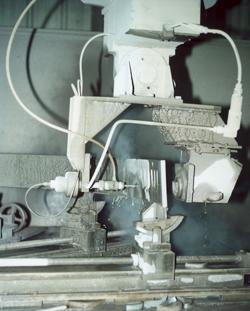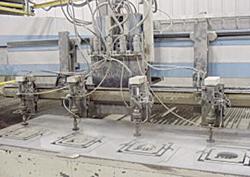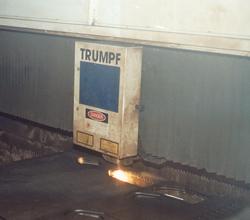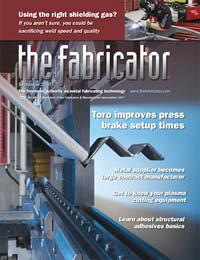Editor-in-Chief
- FMA
- The Fabricator
- FABTECH
- Canadian Metalworking
Categories
- Additive Manufacturing
- Aluminum Welding
- Arc Welding
- Assembly and Joining
- Automation and Robotics
- Bending and Forming
- Consumables
- Cutting and Weld Prep
- Electric Vehicles
- En Español
- Finishing
- Hydroforming
- Laser Cutting
- Laser Welding
- Machining
- Manufacturing Software
- Materials Handling
- Metals/Materials
- Oxyfuel Cutting
- Plasma Cutting
- Power Tools
- Punching and Other Holemaking
- Roll Forming
- Safety
- Sawing
- Shearing
- Shop Management
- Testing and Measuring
- Tube and Pipe Fabrication
- Tube and Pipe Production
- Waterjet Cutting
Industry Directory
Webcasts
Podcasts
FAB 40
Advertise
Subscribe
Account Login
Search
Fabrication in transition
One-time metal supply house becomes a waterjet shop that now offers laser cutting, bending, and assembly
- By Dan Davis
- September 11, 2007
- Article
- Waterjet Cutting

Arcadia's five-axis waterjet cutting machine allowed the company to provide a service that other nearby metal supply houses didn't offer. As a result, the company developed a reputation as a fabricator of large, 3-D stainless steel and aluminum parts.
Which comes first—the purchase orders or the equipment investment? It's not quite the-chicken-or-the-egg question, but it's an interesting debate in the world of metal fabricating.
Management at Arcadia Waterjet, Albany, N.Y., has asked that question at several critical times since the company's founding in 1969. At each time, the question dealt less with simply buying equipment to chase new business, and more with changing the strategic direction of the company.
Arcadia's evolution over the years provides a glimpse into the key decision-making periods. James Sumner founded Arcadia in 1969. Jim had been selling metals on the East Coast since 1950 and, as a sideline, began to sell cutting tools out of the trunk of his car as he stopped at different job sites. While making his rounds he noticed an opportunity to fill the niche of supplying specialty metal to customers looking for quick turnaround on small orders.
Bill Sumner, now Arcadia's president, joined his father full-time in 1975 and the business expanded rapidly. In the mid-1990s the metal supply house adopted waterjet cutting, which was much more compatible with the stainless steel and aluminum it cut for customers. Other supply houses offered thermal cutting, but no one really offered the benefits of a precise, nonthermal cutting technology. By 2005 Arcadia had emerged as the largest waterjet cutting shop in the region. Although no longer primarily a supply house, the company still carries a large metal inventory for its customers. Despite the successful transition, Arcadia wasn't competitive in certain cutting jobs for carbon steel. That led to a purchase of laser cutting technology.
What led to the equipment investments and addition of fabricating services for Arcadia? As many other fabricators know, it's not a simple answer and, as is often the case, it depends on the situation.
Transition No. 1: Metal Supplier to Waterjet Cutter
In the mid-1990s Arcadia wanted to supplement its specialty metals supply business. Other metal suppliers offered minimal fabricating services, so Arcadia wondered how it could stand out.
"You had flame-cut, plasma-cut, and you jumped into EDM [electrical discharge machining]," said Jack Thomas, Arcadia's marketing manager. "We were looking for something in between there, and waterjet fit that niche perfectly. It was ideal for us at the time."
Sumner agreed.
"In fact, when aluminum plate was cut thermally, an inch had to be cut off [back then] and finished to meet specs. Waterjet could make the cuts without all of those worries," he added.
Arcadia jumped into the waterjet business with both feet. The company purchased three machines, one of which was a five-axis machine capable of cutting 3-D parts. Arcadia worked jointly with Jet Edge, a waterjet technology developer from St. Michael, Minn.; motion systems expert PaR Systems Inc. from Shoreview, Minn.,;l+and a customer in the power generation industry to develop a complicated part using 3-D technology.

Arcadia upgraded two of its two-head waterjets to four-head waterjets, which allowed it to be very competitive with other thermal cutting technologies used to fabricate thick parts. The four-head waterjets also can be configured numerous ways, including as a three-head unit, as Arcadia's Plant Manager Sean Rigney demonstrates.
Reflecting on the initial investment, Arcadia Executive Vice President John Abrams laughed. Even with the purchase of the equipment, the business with the power generation customer wasn't locked up.
"That was purely an entrepreneurial purchase," he said.
The gamble paid off, however, weeks later when a contractual relationship began.
Shortly after a second contract was signed with a large medical OEM.
"We set up this customer with a program where we saved them a considerable amount of money by nesting parts," Thomas said. "Our engineering team worked with their engineering team to renest and redesign parts."
Instead of large amounts of scrap, Arcadia nested parts to sit inside parts that were once considered "drops," remnants left over from the original nesting design.
"That was our first indication that we could be a player," Thomas said.
The transformation would not occur overnight. The Arcadia staff spent many weeks on the road spreading the news about waterjet cutting and its benefits. The results were often mixed; people liked the message, but weren't ready to embrace the "new" cutting technology.
"Waterjet cutting in those days was primarily used for cutting stone and wood. It wasn't thought of to be used in manufacturing of precision parts," Abrams said. "With our due diligence on our part and staying with it, the market finally caught up with the technology."
During this time Arcadia emerged as one of the leading waterjet cutters on the East Coast. The company purchased an additional five-axis waterjet table; added two more waterjets; and changed its two-head tables to four-head configurations, which allowed it to achieve faster cutting times and remain competitive when compared to thermal cutting technologies that had improved over the years. In addition, the two tables with four-head cutting capability have very large beds for oversized parts.

Large parts, such as this part for a power generation application and this bus skin, can be fabricated easily on Arcadia's waterjet with a 12- by 22-foot bed.
Specifically, Arcadia has:
- A one-head, two-axis machine with a 6- by 8-ft. bed
- A two-head, two-axis machine with a 4- by 12-ft. bed
- A four-head, two-axis machine with a 10- by 19.5-ft. bed
- A four-head, two-axis machine with a 12- by 22-ft. bed
- Two five-axis machines with one head each and 8- by 12-ft. beds.
After several years of living the highs and lows of a job shop and working through the bust of the power generation market in the early 2000s, Arcadia changed its business approach. The company had evolved into a fabricator of large parts, often in very large volumes, but Arcadia now wanted to develop longer-term relationships with customers, not just waiting for periodic purchase orders.
"We stopped chasing smokestacks and got into target marketing—specific industries," Abrams said. "We want to focus on where our technology fits. If we focused on just power generation, for example, we'd be in trouble."
The focus led Arcadia to concentrate on six main industry segments: architectural/structural, original equipment manufacturers, power generation, transportation, medical, and military. The latter played a large part in the company's next equipment evolution.
Transition No. 2: Waterjet Cutter to Laser Cutter
Waterjet cutting is not known for its speed, especially on thin-gauge material. For cutting thicker gauges, however, Arcadia's four-head cutting systems proved to be very competitive with single-head laser systems.
"Our core competency with waterjet is cutting stainless and aluminum," Abrams said. "It was very difficult to participate in cutting carbon, especially thinner sheets, even though we have multihead machines."
Arcadia long had thought about adding a laser to the fabricating mix. The company realized it was a complementary process to what it was doing because it quoted against laser cutting shops frequently for business. By 2005 the technology had progressed to the point where it was cutting thicker materials with greater ease because of a new generation of powerful resonators.
"We did a marketing survey, and our current customers [said they] would allow us to quote their laser cutting," Thomas said. "So that was the base for us to buy one machine."
Arcadia purchased a TRUMPF 4,000-W Trumatic L4030 with an 81- by 161-in. bed. Soon afterward a company in the rail industry took notice, and Arcadia found almost all of its capacity on its laser occupied cutting 1⁄8- to 1-in. steel for the customer.
In 2006 Arcadia purchased another TRUMPF laser cutting machine, but this time with a 5,000-W resonator, a LiftMaster automated material mover, and a 60- by 120-in. bed. Again, Arcadia knew it could get work for the laser, but it didn't have specific purchase orders lined up. Again, the company didn't have to wait long.

The TRUMPF laser cutting machine opened the door for Arcadia to be more competitive in cutting carbon steel parts. The second laser cutting machine with the LiftMaster material moving device allowed the company to run the laser unattended.
A relationship with a company serving a prime military contractor became available, and Arcadia won the business. The job, which called for fabricating parts for U.S. Army vehicles, pushed Arcadia for several months, according to Abrams. The company had proven it could laser-cut thick parts—1-in.-thick carbon steel and alloys, 3⁄4-in.-thick stainless steel and high-tempered alloys, and 3⁄8-in.-thick aluminum—on a regular basis, and that it could successfully run an unattended shift thanks to the automated material mover on the new laser.
Transition No. 3: Laser Cutter to Metal Bender
Almost all laser cutting shops have a press brake. Arcadia would be no different.
The company purchased a TRUMPF 300-ton, 14-ft. TrumaBend V2300 S press brake in 2006. The press brake was purchased to bend primarily plate. Before the purchase, Arcadia outsourced all bending.
"I initially thought the press brake would be a nice value-added piece of equipment that would get us more laser work, but we have just signed a contract with a customer where we will be doing bending on precut parts," Abrams said.
Transition No. 4: Metal Bender to Full-scale Contract Manufacturer
Arcadia currently has 38,000 square feet of manufacturing space available to serve its customers. The laser cutting shop is located at its corporate headquarters on Erie Boulevard near downtown Albany, and the waterjet shop is a few blocks away on Pearl Street. Sixty-one employees work over two shifts, including some weekends.
The military contract that pushed the company several months ago might lead to more business related to next-generation military vehicle development. Abrams said Arcadia hired its first full-time human resources professional in anticipation of the business.
That may also lead to a new building where Arcadia can consolidate its operations under one roof. The extra room would allow the company to set up flexible manufacturing cells with bending, welding, drilling, tapping, and assembly to fabricate components for the military application.
"When we find the space, our problem is going to be manpower," Abrams said.
Arcadia will approach $20 million in sales in 2007, and management expects more of the same in the future. As always, the company knows business is there to be earned. The key to success is doing the homework and making the appropriate investments at the right time.
The purchase orders aren't signed, sealed, and delivered, but Arcadia knows that through close relations with customers that the transition to the next long-term contract is on its way.
About the Author

Dan Davis
2135 Point Blvd.
Elgin, IL 60123
815-227-8281
Dan Davis is editor-in-chief of The Fabricator, the industry's most widely circulated metal fabricating magazine, and its sister publications, The Tube & Pipe Journal and The Welder. He has been with the publications since April 2002.
Related Companies
subscribe now

The Fabricator is North America's leading magazine for the metal forming and fabricating industry. The magazine delivers the news, technical articles, and case histories that enable fabricators to do their jobs more efficiently. The Fabricator has served the industry since 1970.
start your free subscription- Stay connected from anywhere

Easily access valuable industry resources now with full access to the digital edition of The Fabricator.

Easily access valuable industry resources now with full access to the digital edition of The Welder.

Easily access valuable industry resources now with full access to the digital edition of The Tube and Pipe Journal.
- Podcasting
- Podcast:
- The Fabricator Podcast
- Published:
- 04/16/2024
- Running Time:
- 63:29
In this episode of The Fabricator Podcast, Caleb Chamberlain, co-founder and CEO of OSH Cut, discusses his company’s...
- Industry Events
16th Annual Safety Conference
- April 30 - May 1, 2024
- Elgin,
Pipe and Tube Conference
- May 21 - 22, 2024
- Omaha, NE
World-Class Roll Forming Workshop
- June 5 - 6, 2024
- Louisville, KY
Advanced Laser Application Workshop
- June 25 - 27, 2024
- Novi, MI































